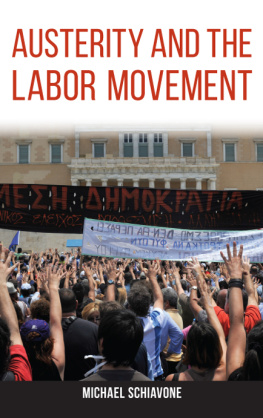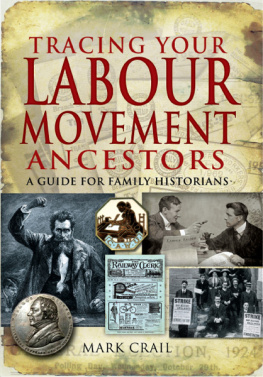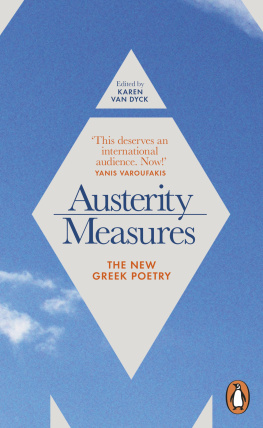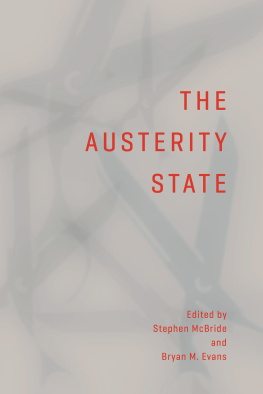Published by State University of New York Press, Albany
2016 State University of New York
All rights reserved
Printed in the United States of America
No part of this book may be used or reproduced in any manner whatsoever without written permission. No part of this book may be stored in a retrieval system or transmitted in any form or by any means including electronic, electrostatic, magnetic tape, mechanical, photocopying, recording, or otherwise without the prior permission in writing of the publisher.
For information, contact State University of New York Press, Albany, NY
www.sunypress.edu
Production, Eileen Nizer
Marketing, Michael Campochiaro
Library of Congress Cataloging-in-Publication Data
Names: Schiavone, Michael, author.
Title: Austerity and the labor movement / Michael Schiavone.
Description: Albany : State University of New York Press, [2016] | Includes bibliographical references and index.
Identifiers: LCCN 2016007687 (print) | LCCN 2016015174 (ebook) | ISBN 9781438462936 (hardcover : alk. paper) | ISBN 9781438462950 (e-book)
Subjects: LCSH: Labor movement. | Neoliberalism. | Economic policy. | Economic stabilization.
Classification: LCC HD4855.S35 2016 (print) | LCC HD4855 (ebook) | DDC 331.88dc23
LC record available at https://lccn.loc.gov/2016007687
10 9 8 7 6 5 4 3 2 1
For Su Lan and Valentina
Acknowledgments
I would like to thank the anonymous reviewers for SUNY Press who offered important recommendations on how to improve the manuscript. Moreover, one reviewer read the original draft and the revised version. This reader offered so many useful suggestions and criticisms that I cannot thank him or her enough. If every reviewer was like this person, academia would be a much better place.
Likewise, Michael Rinella, senior editor at SUNY Press, was great throughout. This was the second time I worked with Michael, and I cannot say enough positive things about him. As I wrote in the acknowledgments of Sports and Labor in the United States : Every author should have an editor like him.
As always, I would like to thank my wife Su Lan and our daughter Valentina. My wife is an inspiration and brings me so much happiness every single day. Without her, this book would have never seen the light of day. As the book was nearing completion, our daughter Valentina came into our lives. She is an incredibly smart and beautiful baby who can always make me smile. I dedicate the book to them.
Chapter 1
Austerity and the Labor Movement
Austerity is the new buzz word in advanced industrialized democracies in academia and the media, and more importantly in the lexicon of politicians from both the Left and the Right. Nowadays it is practically impossible to read a newspaper or watch the news without seeing or hearing the term. Austerity policies have become the new norm throughout both the developed and developing world. In 2009, the soon-to-be United Kingdom Prime Minister, David Cameron, infamously declared that the UK was entering an age of austerity. Austerity policies are now almost a given throughout parts of Europe and are the key component of International Monetary Funds structural adjustment programs. The United States government adopted austerity measures almost by stealth, whereas following its election in 2013, the Australian Liberal government attempted to introduce a range of austerity measures despite the relatively good health of the Australian economy. Austerity is now seemingly the rule rather than the exception, irrespective of the state of a countrys economy.
As to what austerity is and what it entails, the best definition comes from political economist Mark Blyth, who defines austerity as a
form of voluntary deflation in which the economy adjusts through the reduction of wages, prices, and public spending to restore competitiveness, which is (supposedly) best achieved by cutting the states budget, debts, and deficits. Doing so, its advocates believe, will inspire business confidence since the government will neither be crowding-out the market for investment by sucking up all the available capital through the issuance of debt, nor adding to the nations already too big debt.
Blyth goes on to quote University of Chicago academic and austerity supporter, John Cochrane:
Every dollar of increased government spending must correspond to one less dollar of private spending. Jobs created by stimulus spending are offset by jobs lost from the decline in private spending. We can build roads instead of factories, but fiscal stimulus cant help us to build more of both.
However, what austerity entails can vary from country to country. The Economist claims that A government can impose an austerity programme and still spend far more than it receives in the form of taxes; indeed the British coalition government had a deficit of 9.3% of GDP in the first year of austerity, a very high figure by peacetime standards. But because this was less than the 11% of GDP in the year before, it counts as austerity. Nevertheless, at its heart, austerity advocates believe that a government should intervene as little as possible in the workings of the market. In other words, austerity goes hand in hand with neoliberalism. But it is important to note that under austerity measures governments have generally been raising taxes on individuals. Tax increases are not normally associated with neoliberalism. While governments have been raising taxes, primarily personal taxes, they have also been lowering business taxes. It is the general public who must endure tax increases, not business.
While there is a plethora of news stories and the like regarding austerity, one area that is neglected is the labor movements response to austerity worldwide. This book will primarily examine the UK and US labor movements efforts against austerity. As we shall see, the labor movement is seemingly powerless in the UK and the US to prevent or even mitigate austerity policies. This has been a major detriment to the lives of the majority of people in both countries. While the focus will be on the UK and the US, the book will also provide an overview and analyze the labor movements attempt to overturn austerity in Greece, Spain, and Ireland. The common theme throughout is that, despite mass protests (though these are rare in the US), austerity has continued largely unabated in Greece, Spain, Ireland, the UK, and the US, and has caused much human suffering, while having a limited impact, even on the most optimistic account, on improving the economic well-being of each country.
Neoliberalism and Austerity
What led to the rise of austerity? For us to answer that question we first must understand neoliberalism. Neoliberalism, which is the ideology behind the latest rise of austerity, is a revival of laissez-faire liberalism. The proponents of neoliberalism argue that by removing government involvement from almost all aspects of managing the economy, and allowing the market to perform its natural role, this will result in economic prosperity for a country and its citizens. Thus, governments should privatize all public enterprises, slay the inflation dragon, liberalize trade and finance, and embrace austerity policies. Neoliberalism has become such a dominant political ideology that political parties all across the ideological spectrum have adopted neoliberal reforms in both developed and developing countries. Arguably the best analysis of what led to neoliberalism comes from Stephen Gill, who identifies four essential initiators of the neoliberal order: multinational companies, the transnational financial network, transnational elite networks, and the major capitalist countries, such as the US.












